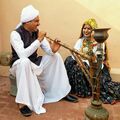Life, culture and traditions of Jat people
| Author:Laxman Burdak, IFS (Retd), Jaipur |
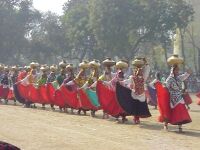
Life, culture and traditions of Jats (जाटों का जीवन, संस्कृति और परम्पराएं)
Life and culture
Main article: Life and culture
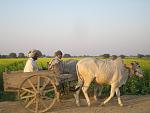
The Life and culture of Jats is full of diversity and approaches most closely to that ascribed to the ancient Aryans of India. The Jat lifestyle was designed to foster a martial spirit. When they lost their kingdom, states and social eminence, they retired to the country-side controlling and tilling the land with their swords girded round their waists. They would draw the sword out of the scabbard at the command of their panchayat to fight with the invaders. Jats are the best cultivators as well as brave and ready fighters.In the government of their villages, they appear much more democratic than the Rajput; they have less reverence for hereditary right and a preference for elected headmen. [1]
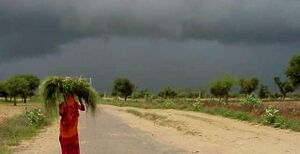
Youth especially Jats are more inclined to sports like Kabbadi and kushti. There is tradition of Akhadas and it has given various national and international level wrestlers. In these times Kushti and Kabaddi are sole source of entertainment in villages on occasions like Holi and Fagun.
Leaving aside some Jats who are in services or in active politics or are in professions like legal , medical or engineering etc., majority of the Jats are engaged in cultivation of lands. They are mostly born in villages and after primary education, acquaint themselves with agriculture and by the age of sixteen , they completely take over to this vocation with their parents. After obtaining maturity, young Jats develop fancy to possess better breed and healthy animals. Till fifty years back, he used to ride on good horse whom he loved most and took pride in horse riding. By the change of animal era to machinery period, Jats too have changes over to tractors and tillers in place of bullocks and jeep instead of horse. However a Jat in a village or on his farm cannot do without one or two buffaloes because without milk, curd , Ghee(butter) and Chaach(cream separated curd), his daily diet remains incomplete. Only five decades before , if a stranger requested a Jat for a glass of water to quench his thirst, he was supplied with a glass of Lassi (diluted curd mixed with sugar). He did not mind if some one extracted one or two sugar-canes, cucumbers or watermelons from his field to feed oneself for taste. It was customary for a Jat to offer a quarter kilo Gud (Indigenous substitute from sugar) to one who happened to be sitting in the Kolowah at the time of its preparation.[2]
Physical features
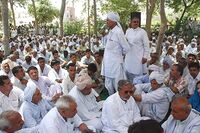
The Jats have pure Aryan physical features. Their wheatish complexion, oval face with a firm jaw, prominent nose, dark eyes, thin lips, well set teeth, long neck, broad shoulders, thin waist and tall stature are unmistakably Aryan. Hardly any Jat will be found with non-Aryan features. They have retained racial purity due to their homogeneity. It can be safely said that if any people have preserved pure Aryan characteristics it is the Jats, Ahirs and Gujars.
A Jat is fearless and frank in expression. He neither likes to receive or extend flattery. Jats maintain both friendship and enmity for generations. An old Jat will not die in peace unless he has explained to his descendants the good or evil deeds done unto him by others and taken promise from them for a return favour or revenge. They are a very hardy lot. There is a popular saying that considers a Jat dead only after thirteen days have passed after his death.
Dr Birereton writes about Jats that -
- "Their intellectual facilities are not brilliant partaking more of shrewedness and cunning than ability".
He further writes about Jat women as under -
- "The Jat women are of very strong physique exceeding man in this respect proportionately speaking. They are not remarkable for personal beauty, but some have fine figures .... but are said to rule their husbands. The prevailing complexion is fair and colour of eyes dark and hair is dark, fine and straight". [3]
Jat languages
Jats usually speak Hindi and its dialects (Rajasthani, Haryanvi, Malvi), Punjabi and its dialects, Urdu, Kashmiri, Dogri, Sindhi and Gujarati. Sikh and Muslim Jats from the Punjab mostly speak Punjabi and its various dialects (such as Maajhi, Malwi, Doabi,Seraiki Pothohari, and Jhangochi). Jats in Haryana and Delhi speak a dialect akin to Hindi, called Jatki or Haryanvi. Jats in Rajasthan and areas adjoining Rajasthan speak Rajasthani and Brij languages. Following languages have content on this site:
Jat costumes
Main article: Jat costumes
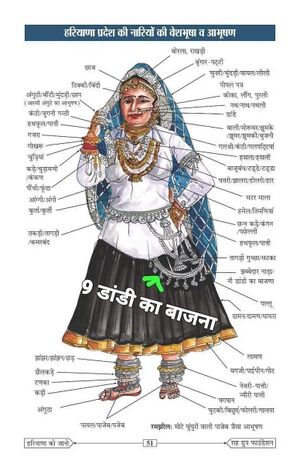
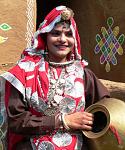
Jat costumes and their dress is simple. The men's dress consists of a turban, shirt, dhoti, jooties and cotton or woolen shawl. Jats in Uttar Pradesh wear white cap which is also famous as "Gandhi Topi". Women wear orhna (veil) shirt or Angia (short blouse) ghagri (heavy skirt) jooties (country made shoes) and heavy ornaments around their necks, wrists and ankles. There are different kinds of ornaments in use in different states. Ornaments are liked by both Jat men and women.
Jat food habits
Main article: Jat food habits
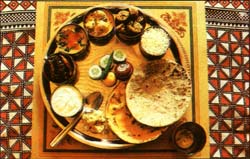

Jat food habits (जाटों का खानपान) are very simple. Jats are mostly non-meat eaters as a result of Vedic and Buddhist influences. Their staple food is wheat or bajra, vegetables and plenty of milk and ghee. Jats cosider non-veg food undesirable but some of Jats started taking non-vege food after German war. Presently the proportion of meat eater Jats is very limited. Jat women are normally quite ignorant about cooking of non-vege dishes. Jats earlier were not in habit of taking wine but it is slowly growing in modern times due to influence of other societies.
Milk, curd and ghee is the main food component of Jats. Almost all Jats keep domestic milching animals. On special occasions halua, kheer and chawal are prepared. Rice is consumed with a lot of ghee and sugar. Rabadi (राबड़ी) prepared from chhachh used to be very common dish in villages. Dal, churma, baati, lapsi, Gulgule and shakarpara are also very common. Papar and mangori are made from moong and moth which are used for vegetables throughout the year. Jat habitations have a plenty of kair and khejri trees. The fruit of kair is used as vegetable and in making curry. Kair is used in pickles and used throughout the year. Khejri pods, called Saangri (सांगरी) in local language, are used as vegetables. Khichdi (also khichdee, khichadi, khichuri, khichari and many other variants) is an Indian dish that contains a combination of rice and lentils. Khichdi is commonly served with another Indian dish called "kadhi". Other common accompaniments are papads, beguni (deep fried eggplants in a besan butter), ghee (clarified butter), achar (oil based pickle), and yoghurt.
Jat professions
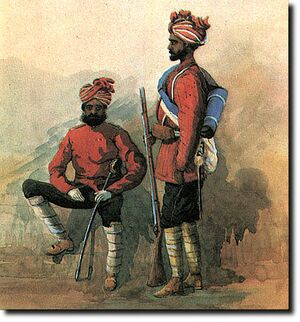
Today we find Jats in all professions. Some of the leading Jats in these professions are mentioned in the following links:
• The Industrialists and Businessmen
The Jats, like most South Asians, are mostly landlords and farmers; however, they are also found in many other professions. Traditionally they have formed part of the land and gentry and ruling upper classes. A large number of Jats serve in the Indian Army, including the Jat Regiment, Rajputana Rifles, Sikh Regiment and the Grenadiers, among others. Jats also serve in the Pakistan Army especially in the Punjab Regiment.
The region inhabited by the Jats in India is one of the most prosperous part of the country on a per capita basis (Haryana, Punjab, and Gujarat are among the wealthiest of Indian states).
A Jat generally goes for only two professions, handed down by his ancestors, agriculture or soldiering, and excels in both. A Jat may starve but will seldom take up a profession involving menial labour for another person. As soldiers they are fearless and loyal but sensitive, and need careful handling and good leadership. As farmers they are very industrious and both men and women work hard on their land. They are very fond and proud of their cattle, which are amongst the finest breed in the world. Jats meet their simple needs from what they produce and are, therefore, self-reliant. This has had two effects. On one hand, they have managed to live in tact for centuries around Delhi, the capital of India, and could never be coerced in to changing their form or character inspite of numerous changes of governments with different ideologies and religions. On the other hand it has hampered their progress in modern times in educational and technical fields, because they stuck to their land.
Jat Religions
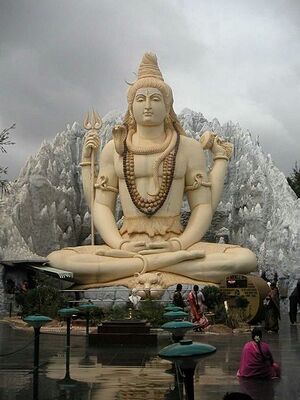
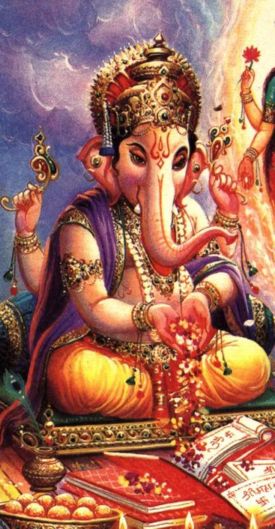
- For on subject Jat Religions in Hindi language see जाट और धर्म
Jats are tolerant in their religious outlook. 'Man may come and men may go but I go on for ever' is a well known proverb which fits well on Jats. Accordingly a Jat is Jat with Jat characteristics, irrespective of the religion that had to be changed from time to time. The Jats being of Aryan stock, in the beginning professed Aryan faith. Later on Jats of many countries adopted Buddhism. [4]
Jats are followers of many faiths and religions. In the past they have been ardent followers of
Today they follow Hinduism, Islam, Sikhism and Christianity.
S. N. Sadasivanin in his book "A Social History of India" writes that the social line dictated by Brahmans was strictly adhered to by Rajputs but the Jats refused to toe it and remained an independent community. The Jats on their own scrupulously allowed widow marriage, prohibited female infanticide and rejoiced at the birth of a female child as bringing prosperity to their clan. The psyche dormant in the Jat is moulded in social ethics of Buddhism and it awakens positive responses to the call of new faith professing social equality. In the western districts of the pre-partitioned Punjab, the Jat is a Muslim, in the central, Sikh , and in the southwest Hindu. In a letter published in the Times of India New Delhi, Chaudhary Charan Singh says, 'Jats have been considered inferior by their coreligionists, the Khatris and Brahmans in the Punjab, that is why according to the census of 1931, 56 % Hindu Jats turned Muslims and Sikhs in the short span of 40 years. This largely led to the creation of Pakistan and Punjabi speaking states." They have earned singular distinction for their rugged and tenacious resistance to Brahmanism designed to impose social inferiority on them. A race of strong, sturdy and tough peasants, they were the bulwark of egalitarian Buddhist society that prevailed from Peshawar to Meerut and Jammu and Udaipur. They are also converted to Vishnois. The Vishnois do not rever brahmans but have their own priests (Sadhs) ordained from the laity. [5]
S. N. Sadasivan further writes that the more the brahmans disparaged , the more the Jats defied them. Islam does profess equality of all before God and refuse to concede the superiority of Brahmans; the Jats therefore embraced Islam. For the same reason Jats in their thousands migrated to Sikhism. The Jats were converted to Islam more by self persuasion than by the allurement and by the use of force. The Jats embraced Sikhism because from the very beginning itself, it has been a religion of equality repudiating the superiority of Brahmins and their meaningless and complex ritualism. The Jats who had never tolerated inequality became followers of Sikhism. Bhai Budha or Baba Buddha [6](1506-1631) by his faith and devotion had become spontaneously the choice for adorning the forehead of Angad, the successor of Guru Nanak (1469-1538), with vermilion mark. [7]
The census in 1931 in India recorded population on the basis of ethnicity. In 1925, according to Professor Qanungo[8] The population of Jats was around nine million in South Asia and was made up of followers of three major religions as shown below.
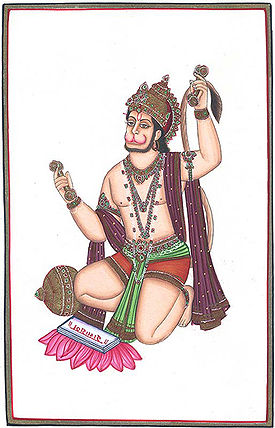
| Religion | Jat Population % |
|---|---|
| Hinduism | 47% |
| Sikhism | 20% |
| Islam | 33% |
In the early 20th century (early 1900), the Jat people constituted about 85 percent of the population of Punjab, nearly 15 percent of the population of Balochistan, Rajasthan, and Delhi, and from 2 to 5 percent of the populations of Sindh, Northwest Frontier, and Uttar Pradesh. During the early 1900s four million Jats of Pakistan were mainly Muslim by faith and nearly six million Jats of India were mostly divided into two large groups of about equal strength: one Sikh, concentrated in Punjab, the other Hindu. The Jat Muslims in the western regions are organized in hundreds of groups tracing their descent through paternal lines.
Worshipping - From the earliest times, they have believed in One God and have worshipped Him. Their mode of worship is to remember God and express their gratitude to Him at any and all times. Jats are devotee of Hindu Gods such as Shiva, Parvati, Ganesha, Krishna, Rama, Hanuman, Gusainji . They also worship local deities such as Gogaji, Mawli, Tejaji etc. In every village there are huge faith in small Khedas i.e small deities.
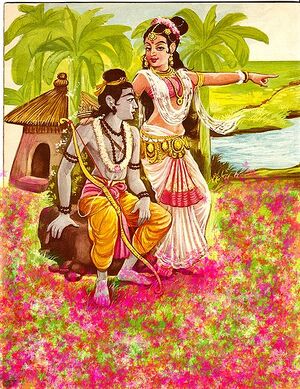
They do not, and have never believed in rituals and worship of idols or evil spirits. That is why no religious shrine of any importance exists in the Jat area. They do, however, believe in a form of ancestor worship. Certain days and customs are observed to propitiate the dead. Every village has a little shrine called Bhaiyan. It is a modest samadhi of the first man who died after that village came into being.
On certain days women visit this shrine, light a Ghee lamp, fold their hands and say, "0 grand father look after our menfolk and cattle". Men seek his blessings before proceeding to perform on important task like house building, marriage or battle. Married couples pay their homage to him the very next day after' the bride comes to her husband's home. This Bhaiyan worship is, however, carried out by individuals when and in whatever manner they choose. There is no fixed prayer, no rituals, no offering of money or foodstuff and no middlemanship of a priest.
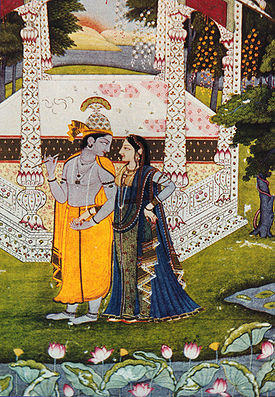
Any religion, which preached oneness of God and condemned superstitions and idol worship easily appealed to and was adopted by Jats in large numbers at different times. When Vedic Hinduism gave place to Pauranic idol worship religion began to be used by priests as a means of livelihood; superstitious and awe inspiring beliefs tales and rituals, were introduced in religion to frighten people into giving offerings to idols and priests who became self appointed agents of God; non Brahmins were debarred from studying Sanskrit and religious books to make them, easily exploitable and ignorant. Jats became Buddhists and remained so long after other people in India went back to Brahmanism consequent to the decline of Buddhism. Buddhist influence is still prevalent amongst the Jats. They don't eat meat, do not wear the sacred thread, and do not stick much for untouchability as other Indians do and respect saints.
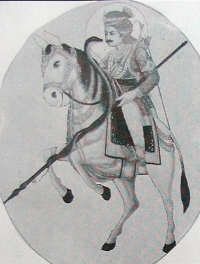
When Buddhism almost disappeared from India, Jats became devotees of saints .The saints not being versed in Sanskrit could not, however, contend effectively with the Brahmins. Some of the saints, who were very popular in Rajasthan , Haryana and Punjab are:
- Tejaji (1074- 1103),
- Dhanna Bhagat (born 1415),
- Guru Jambheshwar (born 1451),
- Bhai Bala(1466 - 1544 AD),
- Guru Jasnath Ji Maharaj (1494),
- Ranabai (1504-1570),
- Baba Buddha (1506-1631),
- Karmabai (1615 - 1634),
- Foolabai (1664 - 1682),
- Garib Das (1717 - 1778),
- Harchand Ram Moond,
- Khema Baba,
- Haridas,
- Nishchal Das (1791-1863),
- Swami Gopal Das (1822-1936),
- Swami Keshwanand (1883-1972)
A large number of Jats became Sadhus. According to 1911 census, the number of Jat Sadhus in Punjab was 37000. Jats however, could never be coerced into accepting the superstitious teachings of the Brahmins, who being the only chroniclers, slanderously labeled the Jats in historical records as atheists, 'rakshash' and low born. These ill feelings between Brahmins and Jats have continued unabated ever since.
When Sikhism came into being, almost all the Jats of Punjab became Sikhs. Some Jats had already adopted Islam and those in European countries had became Christians; thus reducing the population of Hindu Jats, the only people to continue calling themselves Jats, to its present small total.
Arya samaj - When the Sant movement declined, Swami Dayanand Saraswati (1824-1883) founded Arya Samaj on Vedic lines. All the Jats of Haryana, Rajasthan, Brij and Uttar Pradesh readily adopted Arya Samaj as their religion. Swami Keshwanand (1883-1972), Swami Omanand Sarswati (1910 - 2003), Swami Indravesh (1937 – 2006), etc had greater influence on Jats reforms.
The reader will notice that Jats have from time to time adopted only those religions, which preach equality, one God, and condemned superstitious beliefs. A Jat, however, remains a Jat irrespective of his religion- In India, non Hindu Jats, although not calling themselves Jats any longer, have retained their Jat gotras. Qanungo [9] writes that The Jat is a Jat after all, whether be a Hindu, Sikh or Muslim; he tenaciously clings to his tribal name as proud heritage, and with it the tradition of kinship. This retention of the gotras has been the greatest single factor in retracing the lost history of the Jats. Most of the Christian Jats, except a few, have however, given up using their ancient gotra titles.
Jat Organizations

Main article: Khap Main article: Jat Organizations
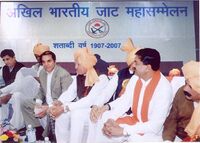
The Jat people have always organized themselves into hundreds of patrilineage Gotras, Panchayat system or Khap. A clan was based on one small gotra or a number of related gotras under one elected leader whose word was law. [10]The big Jat clans now are so big that individual in them are only related to each other by individual that lived typically hundreds years ago. Mutual quarrels of any intensity could be settled by orders of Jat elders. In times of danger, the whole clan rallied under the banner of the leader. The Jat Khap or Panchayat "system is territorial and highly democratic. District and a number of Khaps form a 'Sarva Khap' embracing a full province or state. Negotiations with anyone were done - at 'Sarva Khap' level.
In addition to the conventional Sarva Khap Panchayat, there are regional Jat Mahasabhas affiliated to the All India Jat Mahasabha to organize and safeguard the interests of the community, which held its meeting at regional and national levels to take stock of their activities and devise practical ways and means for the amelioration of the community.[11]
The Association of Jats of America (AJATA) is the main Jat people organization of North America.[12] It performs as the main body, forum and lobby for Jat people issues in North America.
The North American Jat Charities (NAJC) is one of the main Jat people Charities of North America. It performs as a charity for the welfare Jat people in North America.[13]
The Jat Panchayat system is territorial and highly democratic. Every village has its own Panchayat. Whenever there is a problem or dispute in the village, a gathering of the Panchayat is called for every member of the village has a right to attend, express his views and vote for or against a proposal. The maximum available people normally attend. There are no elected or nominated Panchayat officials. Nevertheless, some persons, by virtue of their wisdom and eloquence, are automatically accepted as Panches, (one of the five) and their views are heard and respected. While elders discuss a problem it is customary for younger people not to speak but sit and listen. All decisions are taken after open-hearing, full and voluntary expression of views and consensus vote. Even if one of the contending parties considers the Panchayat decision unfair it is accepted and complied with without question.
A number of villages grouped themselves into a Gohand (corresponding to the present Thana area); a number of Gohands formed a Khap (covering an area equal to from a Tehsil to a District and a number of Khaaps formed a 'Sarva Khaap' embracing a full province or state. For example, there was a "Sarva Khap' each for Haryana and Malwa. At what level a Panchayat should gather depended upon the magnitude of the problem and the territory it involved.
The right of attendance and expression was open to every one, whatever the level of the Panchayat. Generally, however, selected - representatives of the villages attended Panchayats of the 'Gohand' and higher level. Leaders were elected and appointed at 'Khaap' and 'Sarva Khap' level who maintained records of decisions and had the authority to call an assembly.
Negotiations with kings were done - at 'Sarva Khap' level. Some copper plates and papers bearing records of important negotiations are held by Chaudhry Kabul Singh of Village Shoram, District Muzaffarnagar, whose ancestors were leaders of the Sarva Khaap Panchayat.
Some well known occasions, when armies and funds were marshaled under the aegis of Sarva Khaps, are: the Battle of Multan against Huns in Vikram Samvat 564, Battle of Taraori against Mohammad Ghori in 12th Century AD and the battle at the confluence of Hindan and Kali river against Allaudin Khilji in the 13th Century AD in protest against imposition of heavy taxes and interference in private affairs.
Jat social customs
- See main article Jat social customs
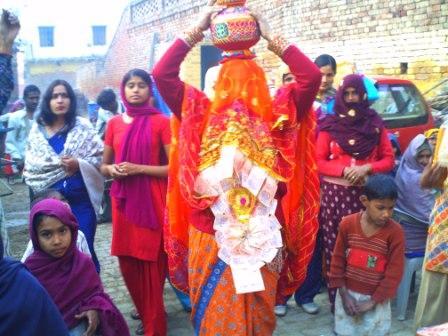
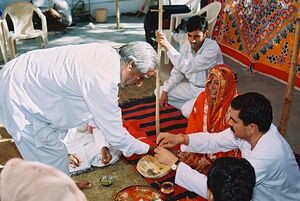
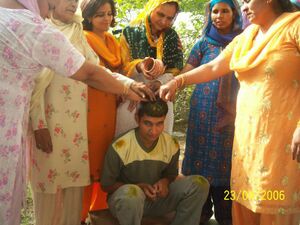

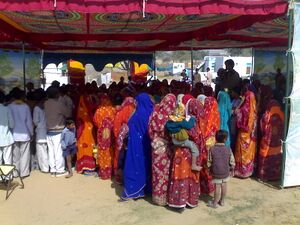
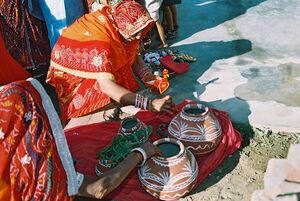
All Jats, irrespective of their official or financial positions in life, have equal social status. The only criterion of superiority is age. If two Jats sit on a bed the elder, even if he is a poor farmer, will sit towards the head of the bed, and the younger, even if he is a very well to do, or is a senior civil or military officer, will sit towards the foot of the bed. If a number of Jats are sharing the same 'hooka' it is the duty of the youngest to hold the 'hooka' and pass it around in turn to the others. The system is thus of a very socialistic nature.
The Jats are required to marry within their community. A Jat boy marrying a non- Jat girl though not encouraged or approved, is nevertheless acceptable- A Jat girl marrying a non Jat boy is, however, taboo, and, should it happen it is considered a permanent blot of disgrace on the girl's family. Boys and girls of the same gotra are considered brothers and sisters to each other. It is therefore, prohibited to marry a girl of one's own gotra, as that would amount to incest. Marriage within the same village is also not permitted even if the boy and girl qualify for marriage according to gotra restriction. Marriages within the same Gohand are discouraged.
This social system adopted by the Jats has a number of advantages. Racial purity is maintained. Within the bounds of the community, maximum cross breeding takes place which promotes good health and prevents physical degeneration) as it occurs in certain communities who marry first cousins. Boys have a sanctimonious regard for the girls of the same village or Gohand as they consider them as future wives. This also cuts down mutual squabbles of sexual origin.
Widow marriage karewa is not only permitted and practiced but is also a social obligation. One year after the death of her husband the widow is asked in the presence of her late husband's relatives, whether she would like to remarry and if so, with whom. Her choice is expected to be limited to the brothers or first cousins of her late husband. The boy, thus chosen, is obliged by custom and tradition bound to accept her. Widows with children and those past their youth do not normally remarry. The burden of their support is however automatically taken on by the nearest relatives of the deceased.
The young and childless widows invariably remarry and are encouraged and even persuaded to remarry even when they don't feel inclined to do so in their state of emotional disturbance.
Widows are looked upon with sympathy and not despised as evil beings as is done amongst other castes such as Rajputs, Brahmins and Baniyas. That is the main reason why a Jatni is never heard of as a prostitute. It is incomprehensible how such a humane custom was ever selected by the Brahmins as the main reason for branding the Jats as irreligious and low. It is not only a very civilized custom but is also fully in keeping with the dictates of the Shastras.
The Joint family system was popular amongst the Jats and large families used to share the same house and hearth. With the advancement of modern civilization, as people are becoming less dependant upon and less tolerant towards each other, the joint family system is going out of vogue. It is still prevalent in the less advanced areas.
See also
- Jat History Thakur Deshraj/Chapter IV
- Glimpse of Rural Life of Haryanavi Jats
- Glimpse of Rural Life of Rajasthani Jats
- Photo Gallery of Traditional Items of Haryanvi Rural Life
- Gramin Rajasthan me Vaivahik Reeti-Rivaj
- Rajasthan ke Gramy jivan ki Jhanki
Gallery
-
राजशाही 'हुक्का' के साथ आनन्दित एक जाट दम्पत्ति
-
राजशाही 'हुक्का' के साथ आनन्दित एक जाट दम्पत्ति
References
- ↑ Kalika Ranjan Qanungo: History of the Jats, Delhi 2003. Edited and annotated by Dr Vir Singh, p.3
- ↑ Mangal Sen Jindal (1992): History of Origin of Some Clans in India (with special Reference to Jats), Publisher - Sarup & Sons, 4378/4B, Ansari Road, Darya Ganj, New Delhi-110002, ISBN 81-85431-08-6, p. 64
- ↑ Thakur Deshraj : Jat Itihas (Hindi), Maharaja Suraj Mal Smarak Shiksha Sansthan, Delhi, 1934, 2nd edition 1992 (Page 126)
- ↑ Mangal Sen Jindal (1992): History of Origin of Some Clans in India (with special Reference to Jats), Publisher - Sarup & Sons, 4378/4B, Ansari Road, Darya Ganj, New Delhi-110002, ISBN 81-85431-08-6, p. 56
- ↑ S. N. Sadasivan:A Social History of India, p. 254
- ↑ http://en.wikipedia.org/wiki/Baba_Budha_Ji
- ↑ S. N. Sadasivan:A Social History of India, p. 255
- ↑ Kalika Ranjan Qanungo: History of the Jats, Delhi 2003. Edited and annotated by Dr Vir Singh
- ↑ Kalika Ranjan Qanungo (2003) :History of the Jats, Delhi, ISBN 81-7536-299-5, p.1
- ↑ Maheswari Prasad:The Jats - Their role & contribution to the socio-economic life and polity of North & North-West India, Vol.I Ed. Vir Singh, ISBN 81-88629-17-0, p.27
- ↑ B.K. Nagla, "Jats of Haryana: A sociplogical Analysis", The Jats, Vol. II, Ed. Vir Singh, p.308
- ↑ (AJATA) Association of Jats of America
- ↑ (NJAC) North American Jat Charities
Back to People


